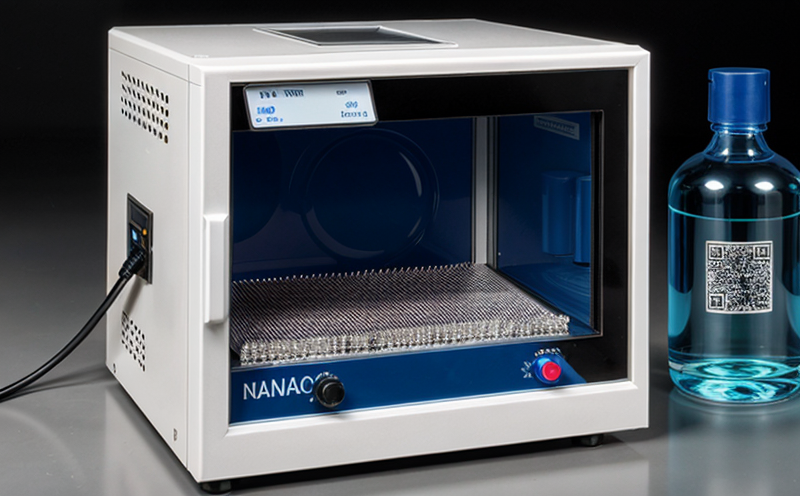ISO 10797 Nanoparticle Sedimentation Testing
The ISO 10797 standard, titled "Particle size distribution—Sedimentometry," provides a method for determining the particle size distribution of suspensions using sedimentation techniques. This test is particularly crucial in the chemical testing sector where nanochemical analysis plays a significant role. The primary objective of this testing method is to ensure that the particles within a suspension are accurately quantified, which is essential for quality control and compliance.
In the context of nanoparticle sedimentation testing, this process involves observing the rate at which nanoparticles settle in a liquid medium under controlled conditions. This allows for precise measurement of particle size distribution without altering the physical properties or structure of the particles themselves. The accuracy and reliability of this method are paramount when dealing with nanochemicals due to their unique characteristics such as high surface area, reactivity, and potential environmental impact.
The testing process begins with proper preparation of the sample suspension. This involves dispersing the nanoparticles in a suitable liquid medium according to strict protocols laid out in ISO 10797. Once prepared, the suspension is introduced into a sedimentation tube where it is allowed to settle under controlled conditions over time. During this period, images or measurements are taken at regular intervals to capture the rate of sedimentation.
The data collected from these observations are then analyzed using statistical methods prescribed in ISO 10797 to calculate the particle size distribution accurately. This analysis takes into account factors such as the initial concentration of particles and the specific gravity of both the nanoparticles and the dispersing medium. The results obtained provide valuable insights into the quality of the suspension, ensuring that it meets industry standards and regulatory requirements.
For industries reliant on nanochemicals, this testing method is indispensable in maintaining product integrity and safety. It helps manufacturers comply with international regulations while also enabling them to optimize production processes by identifying potential issues early on. By adhering strictly to ISO 10797 guidelines, laboratories can offer clients reliable data that instills confidence in their products.
The importance of this testing method cannot be overstated, especially considering the increasing demand for nanochemicals across various sectors including pharmaceuticals, cosmetics, and electronics. In these fields, precision is key to ensuring product efficacy and safety. Hence, employing ISO 10797 nanoparticle sedimentation testing ensures that only high-quality materials enter the market.
To summarize, ISO 10797 nanoparticle sedimentation testing serves as a vital tool in chemical testing labs specializing in nanochemical analysis. By providing accurate particle size distribution data, this method contributes significantly towards maintaining product quality and fostering compliance with international standards.
Scope and Methodology
| Parameter | Description |
|---|---|
| Suspension Preparation | The process involves dispersing nanoparticles in a suitable liquid medium following ISO 10797 guidelines. |
| Sedimentation Tube | A specialized device used for observing the rate of particle sedimentation over time. |
| Image Capture | Regular intervals of image capture to document the settling process accurately. |
| Data Analysis | Analyzing collected data using statistical methods defined in ISO 10797. |
| Parameter | Description |
|---|---|
| Initial Concentration | The starting point concentration of particles within the suspension. |
| Specific Gravity | The ratio of a substance's density to water used in calculations. |
| Settling Time | The duration over which sedimentation occurs, affecting final particle size distribution results. |
| Data Accuracy | The precision and reliability of data obtained through analysis techniques outlined in ISO 10797. |
Customer Impact and Satisfaction
- Ensures product quality by providing accurate particle size distribution data.
- Fosters compliance with international regulations, thereby enhancing customer trust.
- Enables manufacturers to optimize production processes, leading to cost savings.
- Reduces the risk of non-compliance penalties and recalls.
- Enhances product safety through precise measurement techniques.
- Promotes transparency in reporting results, which is crucial for regulatory approval.
- Facilitates better decision-making by offering reliable data insights.
- Supports continuous improvement efforts within manufacturing and research teams.
Competitive Advantage and Market Impact
- Offers a clear competitive edge by providing accurate and reliable particle size distribution data.
- Aids in maintaining compliance with international standards, thereby enhancing brand reputation.
- Enables early identification of potential issues during production processes, reducing waste and costs.
- Promotes innovation through precise measurement techniques that can lead to new product developments.
- Facilitates smoother regulatory approval processes by offering transparent reporting methods.
- Supports strategic planning by providing accurate data for market entry strategies in different regions.
- Contributes to environmental sustainability efforts through precise control of nanochemical usage.
- Enhances customer satisfaction by delivering high-quality products that meet stringent standards.





